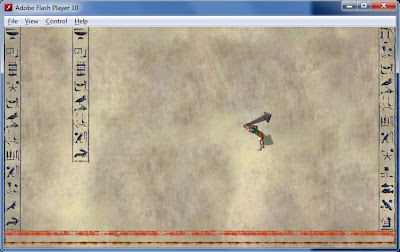The type of game I had envisioned is called an auto-runner. “Canabalt,” created by Adam Atomic in 2009, was the first game of this genre. The mechanics of Canabalt is simplicity itself. The avatar runs across a procedurally generated landscape and accelerates over time. The player has no direct control over the speed that the avatar runs and has absolutely no control over his direction. The only thing the player can do is to press the space bar to make the avatar jump. Players have to time their jumps properly to hurdle obstacles and cross chasms. One false move, however, and it’s game over.
I tried to prototype my idea in GameMaker, but the result wasn’t particularly engaging. I then tried to implement it as a rhythm game, but it played even worse. Stymied, I put my game idea in the backburner for the better part of a year.
Last month, I was searching for other game engines when I came across Stencyl, an interesting tool that uses code blocks to keep users from making syntax errors. The program that I downloaded, version 2.1, allows you to quickly make complete games using any one of several kits. Best of all, the free version of Stencyl has the full feature set for making Flash games. After tinkering with Stencyl for a week, I had prototyped my Ra game as a platformer. Even with minimal implementation, the prototype was fairly engaging and held a lot of promise.
One of the abilities I wanted Ra to have was rolling under low-hanging obstacles, similarly to how ninjas roll away in Tenchu: Stealth Assassins. Implementing the roll was easy enough, but I couldn’t figure out how to show the obstacles without making them look like they were floating in the air. In a whimsical game such as those in Nintendo’s Mario series, floating blocks and platforms are not out of place. In a game set in ancient Egypt, however, those same features would stick out like a sore thumb.
The solution came to me while I was daydreaming again. Why not depict Ra and the Egyptians as animated hieroglyphs on a wall? All floating obstacles would then be wall paintings as well and would therefore be completely appropriate to the game world.
Brilliant, I thought to myself.
This gave rise to another idea. I wanted Ra to be able to swing and flyaway like a gymnast on uneven bars. The question is, how do I depict bars in a two-dimensional world? The answer that came to me was that not everything in the game world had to be two-dimensional. I could have nails jutting from the wall and allow Ra to latch on to them for his acrobatic stunts.
Yet another idea came to mind. Why not add a little excitement to the game by giving Ra some enemies to fight? I could have him fighting the Romans, who supposedly banned the worship of the local gods after conquering Egypt. (This never happened historically, so I’m going to have to use my artistic license here.) In keeping with the theme of having all characters as wall art, the Romans would appear as either mosaics, which are easy to break to pieces, or marble reliefs, which are much more durable. Roman soldiers would make excellent minor enemies for Ra to shatter, but for the end-of-level boss fights, only the major gods of Rome in glorious marble would do.
I knew I had picked the right theme for my game when lots of ideas sprang from it almost effortlessly. I could even see the blurb now:
Avenge yourself and your fellow deities as Ra, Egyptian god of the sun. Drive your worshippers wild to increase your power by undertaking impressive feats of athletic prowess. Steel yourself for wall-to-wall action as you battle the soldiers and gods of ancient Rome in this rousing game of hieroglyphic proportions.
Things are looking good for Project Ra, I’d say.


No comments:
Post a Comment